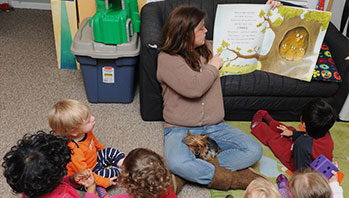- afraid
- brave
- family
- feel
- flapped
- swooped
MA Standards:
Literature: RL.PK.MA.1: With prompting and support, ask and answer questions about a story or a poem read aloud.
Literature: RL.PK.MA.9: With prompting and support, make connections between a story or poem and one’s own experiences.
Social Emotional/Family 6.4: Identify what parents do to provide a safe, healthy environment for their children.
Head Start Outcomes:
Self-Concept/Self-Regulation: Recognizes and labels emotions.
Language Development/Receptive Language: Attends to language during conversations, songs,
stories, or other learning experiences.
Literacy Knowledge/Book Appreciation & Knowledge: Recognizes how books are read, such as front-to-back and one page at a time, and recognizes basic characteristics, such as title, author, and illustrator.
Literacy Knowledge/Book Appreciation & Knowledge: Asks and answers questions and makes comments about print materials.
PreK Learning Guidelines:
English Language Arts 10: Engage actively in read-aloud activities by asking questions, offering ideas, predicting or retelling important parts of a story or informational book.
Science and Technology 26: Observe and describe ways that animals, birds, and insects use various parts of their bodies to accomplish certain tasks and compare them to ways people would accomplish a similar task.
Health Education 16: Recognize and describe or represent emotions such ashappiness, surprise, anger, fear, sadness.
Health Education 20: Describe members of their family and discuss what parents do for their children to keep them safe and healthy.
Read Together: Owl Babies #1

© Commonwealth of Massachusetts, Department of Early Education and Care (Jennifer Waddell photographer). All rights reserved.
Point to and read aloud the title of the book, Owl Babies by Martin Waddell. Encourage children to describe what they see on the front cover.
Before You Read
As you hold up the book cover as children to look closely at the owl's expressions. Ask,
- Can you tell how the baby owls are feeling? How do you think they are feeling? (happy? sad? scared?) Why do you think that?
Provide a listening focus for children. Ask them to listen and look for how the baby owls are feeling as they listen to the story.
As You Read
You may want to shut the shades and dim the lights to create a nighttime atmosphere.
Read with expression, using your voice to show Bill’s growing fear and longing for his mother.
- Point to the owl babies as you read their names: Sarah, Percy, and Bill.
- Invite children to chime in with Bill on the repeating line, “I want my mommy!”
- Use the pictures to clarify the meaning of any words children may not know, such as tree trunk, twigs, branch, and ivy.
- Use your arms and body to demonstrate the meaning of swooped and flapped. Have children imitate your motions.
After You Read
Talk about the story with children. Ask,
- How was this story the same as “But, Mama, But?”
- How do the owl babies feel when they wake up and their mommy is gone? Did you ever have a time when you felt like that? Have children turn to a buddy and tell them a time they have had that feeling.
- How do the owl babies feel when their mommy comes home? (happy, safe) What makes you feel this way?
Take It Further: Talk more about owls with children to discuss what they know about them. Explain that owls are animals that are found in many parts of the world. Say, There are many different kinds of owls and most of them hunt for food at night. Show children picture of various owls for visual reinforcement.
Social Emotional Tip: Presenting situations and reinforcing methods to accommodate a variety of feelings in a constructive way helps promote a sense of well-being in children.
English Language Learners: Show a picture of a child with a sad face. Have children repeat the word sad after you. Model using the word in a sentence: The child is sad. Act out the emotion, and point to the picture that shows the child looking sad. Repeat the activity using another a picture, of a happy face. Have children say the word happy, use it in the sentence, and act it out while pointing to the picture that shows the children are happy. Help children by giving them sentence frames as needed.
